 Earth Forces EquipmentCRAFT a. SA-43 (Hammerhead) Technical Manual SA-43 Blueprint Zip by G. Mandel 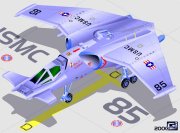 The
SA-43 Endo/Exo-Atmospheric Attack Jet ("Hammerhead") is the main-stay
of the Marine Corps. Their SCRAM engines enable them to fly in
an atmosphere and in the almost complete vacuum of space. Following
in the modular design of aircraft of the late 20th century, Hammerheads
can be adapted for normal combat, search and rescue, and possibly
other missions. The canopies of the craft are also detachable
allowing docking with space platforms. Systems that are known
to exist in the Hammerheads include LIDAR (Laser Infrared Detection
And Ranging), HUD (Heads-Up Display) and ODP (Optical Disk Playback). The
SA-43 Endo/Exo-Atmospheric Attack Jet ("Hammerhead") is the main-stay
of the Marine Corps. Their SCRAM engines enable them to fly in
an atmosphere and in the almost complete vacuum of space. Following
in the modular design of aircraft of the late 20th century, Hammerheads
can be adapted for normal combat, search and rescue, and possibly
other missions. The canopies of the craft are also detachable
allowing docking with space platforms. Systems that are known
to exist in the Hammerheads include LIDAR (Laser Infrared Detection
And Ranging), HUD (Heads-Up Display) and ODP (Optical Disk Playback).
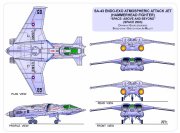 Specs: Specs:Endo-Exo Trans-atmospheric Attack Jet Primary fighter of the United States Marine Corps. Primary Function : Deployment in combat missions (Combat Space Patrol), interception, Close Air Support (CAS) and Colonial Defense, but can also be adapted for SAR (Search and Rescue). Manufacturer: AeroTech Space Division - Newport News, Virginia 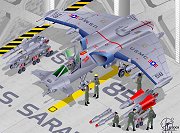 Length
: 11.5 m Length
: 11.5 m Height : 1.7 m Wingspan : 12.5 m Ferry range: Over 2,000 mega statue kilometres Combat radius: N/A Fighter mission: N/A Attack mission: N/A Manoeuverability: N/A 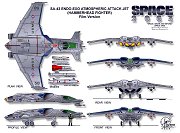 Propulsion
: He3 fuelled SCRAMjet (Supersonic Combustion RAMjet) Propulsion
: He3 fuelled SCRAMjet (Supersonic Combustion RAMjet) Engines : SCRAMjet - enabling the SA-43 to fly from inside an atmosperic envelope to a transorbital fase right into ACM (Air Combat Manoevring, i.e. dogfighting), in the (almost complete) vacuum of space Armament : 1 x frontal, sub-nose gimbal-mounted electro-magnetic railgun (capable of covering a 50° kill-zone) 1 x dual-barrel aft-mounted railgun, mounted in a turret, capable of auto-target seeking and tracking Existing hardpoint configuration : 6 x hardpoints, capable of carrying: - a. Missiles : Spartan space-to-space missile - b. Bombs - c. Pods : for carrying special electronic Eqt or instrument modules 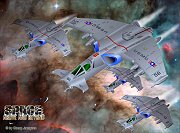 Features:
The SA-43 has various modular components, easily replaced in
case of malfunction. Features:
The SA-43 has various modular components, easily replaced in
case of malfunction.The canopies are detachable, enabling the craft not only to dock on board carriers, but also on various types of space stations. The cockpit usually is lifted up to the flightdeck (hence smaller decks are possible). It also doubles as an escape pos in case of midair emergency. LIDAR : Laser Infrared Detection And Ranging. Long Range, configurable. Can track and engage up to 100 independent targets. HUD : Heads-Up Display. Mainly used for displaying flight parameters, navigational information and overall combat intelligence. ODP : Optical Disk Playback. Used for mission data recordings. Can be used lateron for mission evaluation. Crew: 1 Introduction date: N/A Unit Replacement Cost: N/A Mission: Specific SA-43 tasks include: - Intercept and destroy enemy craft in conjunction with ground or airborne fighter control under all-endo/exo conditions. - Conduct day and night close air support. - Conduct day and night deep air support. Deep air support consists of LIDAR search and attack, interdiction, and strikes against enemy installations using all types of weapons compatible with assigned craft. - Conduct armed escort of friendly craft. - Be able to operate from spacecraft carriers, advanced bases, and expeditionary airfields. - Be able to deploy or conduct extended range operations employing aerial refueling. b. ISSAPC Technical Manual ISSCV Blueprint Zip 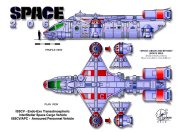
The Inter Solar System Armored Personnel Carrier is designed to interface with the ISSCV, and provides the means of transportation for military operations. It has been nicknamed "Flying Winnebago", due to its resemblance to that vehicle. Click on the image to see the blueprint courtesy by Georg Jörgens 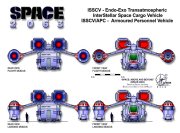 Specs: Specs:Endo-Exo Trans-atmospheric InterStellar Space Cargo Vehicle/Armoured Personnel Vehicle Primary Function : A smaller transport ship used to travel from one system to another. Manufacturer : AeroTech Space Division - Newport News, Virginia Length : 50 meters Height : 4.8 meters Wingspan : 4 meters Ferry range: N/A Combat radius: N/A Fighter mission: N/A Attack mission: N/A Manoeuverability: N/A Propulsion : 6 HE3 Fuselage Core Realspace Thrusters with 7.6 Gs max acceleration Engines : 2 SCAMjet intakes for Atmospheric Flight Armament : Nose mounted 12 megawatt twin laser pulse cannon turret capable of 180 degree swivels but with low elevation and depression, a back mounted 8.4 megawatt twin laser pulse cannon turret capable of 360 degree and -3 depression swivels that are used with a headgear guide and two side hatch mounted 10 mm Gauss laser machine cannons located at the starboard and port sections of the ship. Features: The vessel carries a box-like cargo or troop compartment, which can be dropped off. LIDAR : Laser Infrared/Imaging Detection And Ranging. Long Range, configurable. Can track and engage up to 100 independent targets. HUD : Heads-Up Display. Mainly used for displaying flight parameters, navigational information and overall combat intelligence. ODP : Optical Disk Playback. Used for mission data recordings. Can be used lateron for mission evaluation. Crew : 2 pilots / 1 board sniper / 1 navigator Introduction date: N/A Unit Replacement Cost: N/A Mission: This is the main combat configuration of the ISSCV series. The APC is capable of transporting 30 soldiers to touch down and extraction sites. The APC module also contains an EW station equipped with a LIDAR system capable of monitoring enemy activity. c. ISSCV 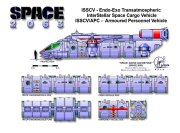 The Inter Solar System Cargo Vessel is a large, rectangular
modular containment vessel capable of carrying human and mechanical
cargo alike. The ISSCV is transported by the ISSAPC, and can
serve as a base of operations.
The Inter Solar System Cargo Vessel is a large, rectangular
modular containment vessel capable of carrying human and mechanical
cargo alike. The ISSCV is transported by the ISSAPC, and can
serve as a base of operations. Click on the image to see the blueprint courtesy by Georg Jörgens
weaponry d. K-Bar The K-Bar is the standard issue Marine Corps fighting knife. While the 20th century version was not intended to double as a bayonet, the 21st century version obviously is. e. M-590 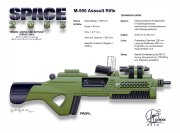 The M-590 Assault Rifle is the standard issue Marine Corps firearm.
It is a projectile weapon, fired by squeezing the handguard.
It can be mounted with a scanner.
The M-590 Assault Rifle is the standard issue Marine Corps firearm.
It is a projectile weapon, fired by squeezing the handguard.
It can be mounted with a scanner. Click on the image to see the blueprint courtesy by Georg Jörgens f. M-70 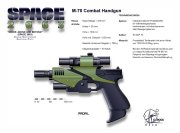 The M-70 handgun is the standard issue Marine Corps semi-automatic
hand gun. It is a projectile weapon, fired by squeezing the
handguard. It can be mounted with a scanner.
The M-70 handgun is the standard issue Marine Corps semi-automatic
hand gun. It is a projectile weapon, fired by squeezing the
handguard. It can be mounted with a scanner. Click on the image to see the blueprint courtesy by Georg Jörgens g. Smart Grenades  Smart grenades are
"launched" by tossing them into the air. Their tiny gyros and
fins propel these high-tech devices through the air using their
"intelligence" to seek out the target. If a target manages to
temporarily conceal itself, these devices are able to halt and
hover in mid-air, waiting for the right moment to strike. The
grenades are also known as smarties. Smart grenades are
"launched" by tossing them into the air. Their tiny gyros and
fins propel these high-tech devices through the air using their
"intelligence" to seek out the target. If a target manages to
temporarily conceal itself, these devices are able to halt and
hover in mid-air, waiting for the right moment to strike. The
grenades are also known as smarties. electronics h. LIDAR  Instead
of RADAR scanners, they use LIDAR, probably standing for Laser
Imaging(Infrared) Detection and Ranging.
It's able to be jammed, and is hampered by debris, like asteroids. Instead
of RADAR scanners, they use LIDAR, probably standing for Laser
Imaging(Infrared) Detection and Ranging.
It's able to be jammed, and is hampered by debris, like asteroids.
The Chigs have an experimental system to jam LIDAR, effectively cloaking (or making invisible) the ship with the jammer. i. ScRAMScoop/Jet Propulsion Propulsion system using huge electromagnetic fields to collect interstellar hydrogen and then with the aid of controlled fusion, push the drive forward at sublight speeds. As the speed of the object increases, the drive becomes more efficient -- as does the effect of relativity. Ramscoop drives cannot operate at speeds of less than 700 m/s due to the incredible sparsity of hydrogen in interstellar space. j. Eckerly Drive Travel through normal space was powered by a fusion engine. An electromagnetic ramscoop collects the interstellar free hydrogen, filters the deuterium from the normal hydrogen and pumps both elements to the drive bottle. In the drive bottle, the deuterium is accelerated to .9c and is collided with a stream of accelerated He3. The resulting fusion reaction is neutron free, and used to propel the ship forward using the filtered normal hydrogen as ejecta. As He3 is relatively rare, it would be stored in tanks on board for use in the engine. Mining probes on the Jovian planets would distill the He3 from other gases and refuel ships for their travels. The next major change in space travel came with Dr Eckerly. On April 12 2014, Dr. Eckerly activated his graviton transceiver. This device was intended to be used to communicate between stars, but the side effect it created was far more important than its original purpose. A ship equipped with an Eckerly drive could have artificial gravity on board, saving the crew from advanced skeletal depletion on long journeys. The same ship could also give itself a virtual inertia of zero, bypassing the theories of relativity. Unfortunately, activating the Eckerly drive with the intention to reduce the ship's inertia could have devastating effects: too close to a gravitational well, and the ship could collapse on itself, too close to a source of energetic photons (like a star) and the ship would collapse on itself. After turning several ships and crews into spheres of neutronium, the drive was considered too dangerous. Only the military remained interested and today the secrets of its successful use remain a guarded military secret. military issue apparel k. Flightsuits (image source: ebay)  The
Marines of 2063 wear normal military issued flightsuits, normally
used by Air Force and US Marine Corps pilots of today. Olive
seems to be the regular colour but certain units and wings of
the USMC have been issued other colours as well, e.g. The Angry
Angel's black flightsuits. The
Marines of 2063 wear normal military issued flightsuits, normally
used by Air Force and US Marine Corps pilots of today. Olive
seems to be the regular colour but certain units and wings of
the USMC have been issued other colours as well, e.g. The Angry
Angel's black flightsuits.Usually, six patches are at fixed areas on the flightsuit: USMC globe and eagle patch, left upper shoulder squadron patch: left upper shoulder beneath the globe and eagle air wing patch: lower left between chest and waist name patch: right upper breast squadron unit patch: lower right between chest and waist nation's flag: left lower shoulder/arm united nations flag: right lower shoulder/arm Those squadrons who have participated in the Mars HIST (first training mission without a commissioned officer) may wear the Mars patch underneath the united nations flag on the right mid section arm. l. Armour (image source: ebay)  Battle armour as worn by ground personnel in battle situations.
Battle armour as worn by ground personnel in battle situations.Covered with olive netting, USMC patch and covers the spine in the back and shoulders, chest in the front. For the show they were made out of Ice Hockey chest protectors.  Flight
armour as worn during flight patrols and dog fight. Just a plain
Kevlar chest and back plate, with Titanium enforcements. Flight
armour as worn during flight patrols and dog fight. Just a plain
Kevlar chest and back plate, with Titanium enforcements.For the show the Riot gear of the Italian Police from the 1960's was used and sprayed in black and silver. Two different versions are known in the US Marine Corps:  Kevlar
ground helmet Kevlar
ground helmet fitted with radion transmitter, receiver and controls and helmet light. Covered with combat olive turpuline, it is a direct successor to the Kevlar helmets of the late 20th century. Kevlar flight and rebreather helmet (image source: SciFi & Fantasy Models magazine)  The
flighthelmets of USMC pilots double up as both flighthelmets
and ground combat rebreather helmets. The
flighthelmets of USMC pilots double up as both flighthelmets
and ground combat rebreather helmets.The flighthelmets are normally customized for its owner, brightly coloured, with its owner's callsign as well as unit patch emblazoned on the front and the sides. The flight helmets have exhausts which are conencted via cable and tubes at the upper half of the Hammerhead's pit. They pump oxygen into the helmet. 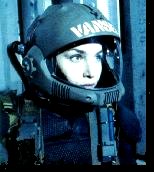 Understandably,
these bright helmets are not suitable for ground to ground battle,
so every Marine has a second set of the flighthelmet, called the
rebreather helmet and is used in hostile, non-oxygen breathable
atmospheres and are mostly olive with the name of the user in
front. These helmets need to be hooked to the rebreather back
pack and the Marines have to watch their backs and especially
the tubes, as these are quite volatile to lucky shots and knives. Understandably,
these bright helmets are not suitable for ground to ground battle,
so every Marine has a second set of the flighthelmet, called the
rebreather helmet and is used in hostile, non-oxygen breathable
atmospheres and are mostly olive with the name of the user in
front. These helmets need to be hooked to the rebreather back
pack and the Marines have to watch their backs and especially
the tubes, as these are quite volatile to lucky shots and knives.n. Rebreather Backpacks (image source: ebay)  The
rebreather backpack is used in hostile, non-oxygen breathable
atmospheres and is mostly sprayed in olive. Helmets are hooked
to the rebreather back pack and the Marines have to watch their
backs and especially the tubes The
rebreather backpack is used in hostile, non-oxygen breathable
atmospheres and is mostly sprayed in olive. Helmets are hooked
to the rebreather back pack and the Marines have to watch their
backs and especially the tubes |
| Disclaimer: The characters and situations of Space:
Above And Beyond are legal property of James
Wong and Glen
Morgan, Hard Eight Production and 20th Century Fox Television.
No copyright infringement intended. All site graphics, original texts, and content other than specified © DrkNite. Fan art, fan photos, and other contributed materials © to their respective owners. All rights reserved. |